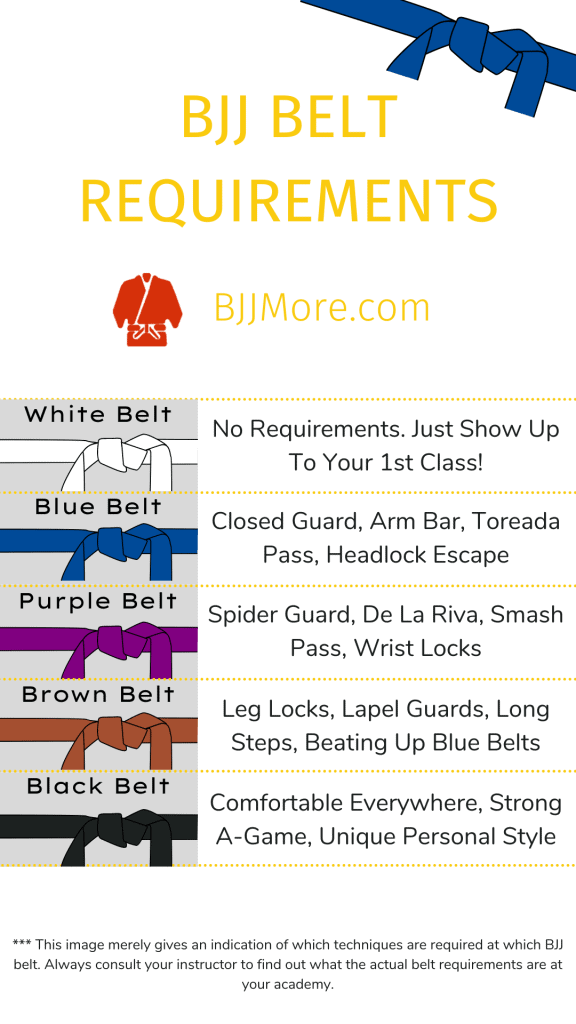BJJ belt requirements are mysterious to those that are new to Brazilian jiu jitsu. This can be incredibly frustrating, because you want to get better at BJJ, but you don’t even know what you’re supposed to focus on. In this article I explain what the belt requirements are in BJJ for the white belt, blue belt, purple belt, brown belt and black belt to help you focus your training efforts.

What are BJJ Belt Requirements?
BJJ belt requirements are the things you need to do in order to be eligible for promotion to the next belt in Brazilian jiu jitsu. These requirements mostly revolve around BJJ techniques that you need to master, but also include soft skills such as knowledge of the art and mat etiquette. Belt requirements are strictly defined at some gyms, and are more general guidelines at other gyms.
What Belts Are There In BJJ?
The BJJ belt system has 5 belt colors at the adult belt level: white, blue, purple, brown and black. There’s also the gray belt, yellow belt, orange belt and green belt specifically for the youth BJJ practitioner. And Gracie jiu jitsu has added a technical blue belt and a pink belt that you can earn after finishing a self defense program at a Gracie Academy.
Why Does BJJ Have Belt Requirements?
BJJ has belt requirements to determine who is worthy of which belt rank. There’s a unique meaning to each BJJ belt and also a practical purpose. At most gyms, classes are separated between colored belts and lower belts and sometimes colored belts can teach BJJ classes to lower belts. Most importantly, your belt indicates your skill level, so that people can adjust how hard they spar with you.
Are BJJ Belt Requirements The Same At Every Gym?
No, BJJ belt requirements are not the same at every gym. In fact, different gyms can have wildly different belt requirements. This makes it so hard to understand for beginners what white belts should focus on to get to the next belt in BJJ. However, there are still some common elements that almost every gym puts in their belt exams or promotion requirements.
What Are The Most Important BJJ Belt Requirements?
BJJ belt requirements can be divided into four general categories. I’ll break down the most common types of requirements to move up in belt level here.
Technique
Technique is the most important component of the BJJ belt requirements, and I’ll elaborate on it in the rest of this article. At each belt you’re expected to learn certain moves and positions, which increase in difficulty as you get to higher belts. For example, at white belt you’re probably expected to learn a few sweeps and submissions from closed guard, and at purple belt you’re probably expected to be aware of what a berimbolo is.
Competition and Sparring
Competitions, or more generally sparring, is important at most BJJ gyms.It’s quite uncommon nowadays to require students to compete, but jiu jitsu practitioners are still expected to perform techniques in sparring. BJJ is not judo or karate, so it’s not enough to show that you can do techniques in the air or with a cooperative partner. You need to perform techniques on a fully resisting opponent to prove that you really learned it.
Time
It’s important to realize that almost all BJJ gyms require you to put in a certain amount of time at each belt. How long it takes to get each belt in BJJ depends on many factors, but it’s usually between 1 to 3 years. This means that regardless of how talented you are, and regardless of how much you’re dominating everyone at your gym, you still shouldn’t expect to get promoted within 1 year. And this time resets when you move to a new gym, because they’ll want to get to know you there before they promote you to a new belt.
Mat Etiquette
Finally, mat etiquette is an important belt advancement requirement. This includes basic things, such as being respectful to your instructor and fellow students and adhering to some important hygiene rules. It also includes some of the unwritten rules in BJJ, such as generally making way for higher belts, and not gossiping about who you tapped out in training.
BJJ Belt Requirements And Curriculum Examples
Maybe the best way to better understand BJJ belt requirements and curriculums is to look at some real life examples. So below I link out to the curriculums and belt requirements that some actual BJJ gyms use:
- Gracie Sydney grading syllabus: this is a very easy to reference and understand grading syllabus, that specifies some specific techniques and some more general requirements (such as ‘8 takedowns’, without specifying which ones you need to know).
- Auckland BJJ belt requirements: note that self defense moves are included in these belt requirements, and that requirements are formulated as ‘2 sweeps from half guard’ which leaves students room to choose their own options.
- Gracie University Blue to Purple Belt Requirements: note that this curriculum is incredibly detailed, specifying over a 100 moves that you’re supposed to know split out over different levels of stripes.
- Cache Valley Curriculum: note that this BJJ curriculum refers to a specific dvd (Pedro Sauer’s blue to purple belt) and includes some self defense techniques, some of which are even knife defense moves.
- Beyond Grappling Club BJJ Syllabus: note that this syllabus describes the technique requirements very generally and also includes a general knowledge of the art and history of BJJ and adherence to what they consider the proper code of conduct for members of their club.
BJJ Belt Requirements For White Belt, Blue Belt, Purple Belt, Brown Belt and Black Belt
As I explained above, BJJ belt requirements differ across gyms. But, I can give you a general indication on which techniques you’re expected to learn at which belt level. Just make sure that you check with your instructor whether this is accurate for the BJJ belt system that your gym uses.
| BJJ Belt Rank | Required Techniques |
|---|---|
| White belt | No requirements |
| Blue belt | Closed guard, arm bar, toreando pass, headlock escape, mount escape |
| Purple belt | De la riva guard, smash pass, spider guard, wrist locks |
| Brown belt | Leg locks, lapel guard, long step passes |
| Black belt | Be comfortable everywhere, have a strong A-game, have your own style |
BJJ White Belt Requirements
There’s only 1 requirement to get a white belt in Brazilian jiu jitsu: show up to your first class. After this, there’s requirements to get your first, second, third and fourth strip on your white belt. Learn more about white belt stripe requirements here.
BJJ Blue Belt Requirements
There are several requirements to get to the blue belt level in BJJ. The most common requirements are to know multiple escapes and submissions from the major dominant positions in BJJ: mount, back mount and side control. Further, you’re usually expected to learn some submissions and sweeps from some of the most common guards in BJJ: closed guard, half guard, butterfly guard, de la riva guard, collar sleeve guard, single x guard and x guard.
You can also check out this video from Roy Dean in which he explains his requirements ro rise to the blue belt level.
BJJ Purple Belt Requirements
The requirements to get a purple belt in BJJ usually revolve around building your offense and developing at least 1 strong open guard position. A purple belt in BJJ is supposed to be dangerous compared to any untrained opponent. One of the main ways you do this is by building an A game, a set of techniques that you can confidently use against opponents of equal and even higher skill. For example, at purple belt I developed my Diesel squeezel (a guillotine variation) which I could occasionally tap black belts with. At the same time, a purple belt is not supposed to have any major holes in his game anymore that leave him vulnerable to athletic white belts.
BJJ Brown Belt Requirements
The requirements to become a brown belt in BJJ revolve around building out your game. To become a purple belt you developed a small A game, and to become a brown belt you build this out to a much wider system. For example, my small A game revolved around a guillotine variation, and at brown belt I connected this with D’arces, anaconda chokes, back takes and a strong mount game. Additionally, in the gi, at the brown belt level more leg locks are added to the game, and many gyms require acquaintance with these before you get promoted.
Learn more about BJJ brown belt requirements here.
BJJ Black Belt Requirements
The requirements to become a black belt jiu jitsu practitioner probably differ the most across different gyms. Symbolically, the black belt is the most important belt because you become a true representative of the martial art, and you implicitly become a teacher of jiu jitsu yourself. At the same time, nobody expects you to know all of jiu jitsu to become a black belt – that would be impossible, because nobody knows everything about jiu jitsu. But, you’re supposed to be able to individually represent your version of our art.
BJJ Red Belt Requirements
The requirements for a red belt in BJJ are to train and coach as a black belt for at least 2 years. However, this is not enough. The red belt is an honorary belt and is only given to people that made a special contribution to the sport. The red belt functions as a ‘hall of fame’ in this regard. It’s believed that there are currently only 42 red belts in the world, but nobody knows for sure.
BJJ Belt Test, Graduation & Promotion Ceremony
Some BJJ gyms test whether you meet the requirements for your next BJJ belt at a graduation ceremony. At this belt test, you might be asked to perform the techniques that your instructor expects you to have mastered in order to qualify for the next belt. Or you might be asked to spar with different partners so that your instructor can assess your level. Or your gym might not do any belt test at all, and simply host a belt promotion ceremony based on how everybody performs during the normal classes.
